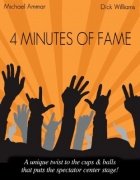Created: 08/22/2014
Updated: 01/23/2022
Cups and Balls
You could easily call The Cups & Balls the oldest trick in the book. It's a trick that dates back centuries and despite being "an old trick", it's just as mesmerizing today as it was hundreds of years ago. There's never been a time in magic history, as there is today, that so many products are available dedicated to this one effect.Its versatility is what has drawn magicians to it over and over again. The Cups & Balls isn't just one trick, it's many tricks combined into a single presentation which magicians make unique through their own personalities. For a time a magician was judged on his skill based on his ability to perform the Cups & Balls. Asked a hypothetical question "If you were only able to perform and study one trick for the rest of your life, what would it be?" many magicians answer "The Cups & Balls."
For close-up magicians The Cups & Balls is like performing a stage illusion. It's almost larger than life in a close-up setting. Yet, despite being branded as a close-up trick, it can be performed on stage in front of hundreds of people without losing the impact of the effect. For centuries street magicians have presented the Cups & Balls as the finale of their shows and as the effect that helps to get money in their hats.
Top magician's Ricky Jay and Lance Burton have closed TV specials with The Cups & Balls. Ricky Jay performed it as the finale to his legendary Ricky Jay & His 52 Assistants show. Paul Gertner, Michael Ammar and Michael Skinner have presented it on TV on The Tonight Show.
A presentation can include appearances, disappearances, penetrations, transpositions, transformations and more. Some complex routines will include all of these while simpler routines may only include one or two of these effects. It's up to the performer and their abilities.
For many the Cups & Balls starts as simple beginner's trick found in a magic kit. That's a great place to start and the basic principle of the trick isn't too different from the sets of expensive professional-level cups. That is part of the appeal of the trick because you can grow with it. As you study more complicated routines, you typically don't have to learn how to use different props. A basic set of cups and balls will carry you for several years as you discover the possibilities with the effect. There's no need to start out with the most expensive set of cups. As your knowledge of the effect increases you will learn what the best set of cups are for you.
Gaining access to professional routines has never been easier than it is today. Here are a few resources to start with:
Many contemporary routines are based on Dai Vernon's Cups & Balls routine found in The Dai Vernon Book of Magic. There are countless professionals who do the Vernon routine as written in the book and other professionals, such as Michael Ammar and the late Michael Skinner who have used Vernon's routine as the foundation for their own routines.
Audiences love the Dai Vernon routine, which is why it's so popular with magicians. While some routines can be confusing to watch, the sequences for the Vernon Routine are easy to follow and are progressively more amazing.
Michael Skinner's Impromptu Cups & Balls Routine is an easy routine to learn for the intermediate sleight of hand performer, yet powerful enough to amaze any audience, including magicians. One of the advantages of Michael Skinner's routine is that a special set of cups is not required. Any cups, such as coffee cups, Styrofoam cups or even paper and plastic cups can be used.
 Michael Ammar's 4 Minutes of Fame is one of the most unique twists on The Cups & Balls in many years. It not only puts the spectator in the spotlight, but also puts the props in their hands. Not only are they presenting the routine, but they are just as amazed as the audience is as the magic happens in their own hands.
Michael Ammar's 4 Minutes of Fame is one of the most unique twists on The Cups & Balls in many years. It not only puts the spectator in the spotlight, but also puts the props in their hands. Not only are they presenting the routine, but they are just as amazed as the audience is as the magic happens in their own hands.
Maestro Leonardo Cups & Balls is one of the most innovative cups and balls routines. It's a routine that earned him a standing ovation from magicians at an IBM competition in 2008. There are no moves in the routine that relate to any other cups and balls routine and nothing difficult about the routine.
Nowadays it can be difficult to find a cups and balls routine that doesn't look like a variant of the Dai Vernon routine. The legendary cups and balls routine from Vienna magician Kurt Freitag is such a routine. There are unique moves and sequences not found in other routines as well as integrating a classic sponge ball routine logically into the presentation.